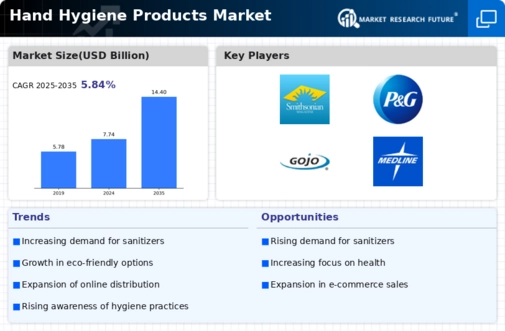Market Share
Hand Hygiene Products Market Share Analysis
The market trends of hand hygiene products are experiencing significant growth and evolution, driven by various factors influencing consumer behavior, industry innovation, and public health priorities. Hand hygiene has emerged as a critical aspect of everyday life, particularly in light of global health crises such as the COVID-19 pandemic, which has underscored the importance of regular handwashing and sanitation practices. As a result, the market for hand hygiene products has expanded rapidly, with a wide range of offerings catering to diverse consumer needs and preferences.
One notable trend in the hand hygiene products market is the increased demand for antibacterial and antimicrobial solutions. Consumers are seeking products that offer effective protection against germs, bacteria, and viruses, driving demand for hand sanitizers, antibacterial soaps, and disinfectant wipes. Manufacturers are responding to this trend by developing formulations containing ingredients such as alcohol, hydrogen peroxide, and benzalkonium chloride, known for their antimicrobial properties. These products provide consumers with peace of mind and confidence in their ability to maintain clean and germ-free hands, especially in high-traffic public settings.
Another key trend shaping the hand hygiene products market is the growing emphasis on skin health and moisturization. Frequent handwashing and sanitizer use can lead to dryness, irritation, and skin damage, prompting consumers to seek products that offer gentle cleansing and hydration. Manufacturers are innovating by incorporating moisturizing ingredients such as aloe vera, glycerin, and vitamin E into their formulations to prevent dryness and maintain skin barrier function. Additionally, the rise of fragrance-free, hypoallergenic, and dermatologist-tested options caters to consumers with sensitive skin or allergies, enhancing inclusivity and accessibility in the market.
Moreover, sustainability and eco-consciousness are driving market trends in the hand hygiene products segment. With increasing awareness of environmental issues such as plastic pollution and carbon emissions, consumers are seeking sustainable alternatives to conventional single-use products. Manufacturers are responding by introducing eco-friendly packaging, refillable dispensers, and biodegradable ingredients in their hand hygiene products. Additionally, the proliferation of organic and natural formulations made from plant-based ingredients appeals to environmentally conscious consumers seeking safer and more sustainable options for hand hygiene.
The rise of e-commerce and online retail channels is also influencing market dynamics in the hand hygiene products sector. Consumers increasingly prefer the convenience of shopping online, where they can browse a wide selection of products, compare prices, and read reviews from the comfort of their homes. This shift towards e-commerce has led to the emergence of online-exclusive brands, subscription services, and direct-to-consumer models, offering consumers greater flexibility, accessibility, and customization in purchasing hand hygiene products.
Furthermore, public health initiatives, government regulations, and industry standards play a significant role in shaping market trends and consumer behavior in the hand hygiene products market. Public health campaigns promoting handwashing and sanitation practices raise awareness and educate consumers about the importance of good hand hygiene habits. Government regulations and standards for product safety, efficacy, and labeling ensure that hand hygiene products meet quality and performance requirements, fostering consumer trust and confidence in the market.
In conclusion, the market trends of hand hygiene products are driven by factors such as effectiveness, skin health, sustainability, e-commerce, and public health initiatives. As consumers continue to prioritize cleanliness, health, and environmental sustainability, the hand hygiene products market is expected to witness sustained growth and innovation. By offering innovative products that meet evolving consumer needs and preferences while adhering to industry standards and regulations, manufacturers can capitalize on opportunities in this dynamic and essential segment.








Leave a Comment